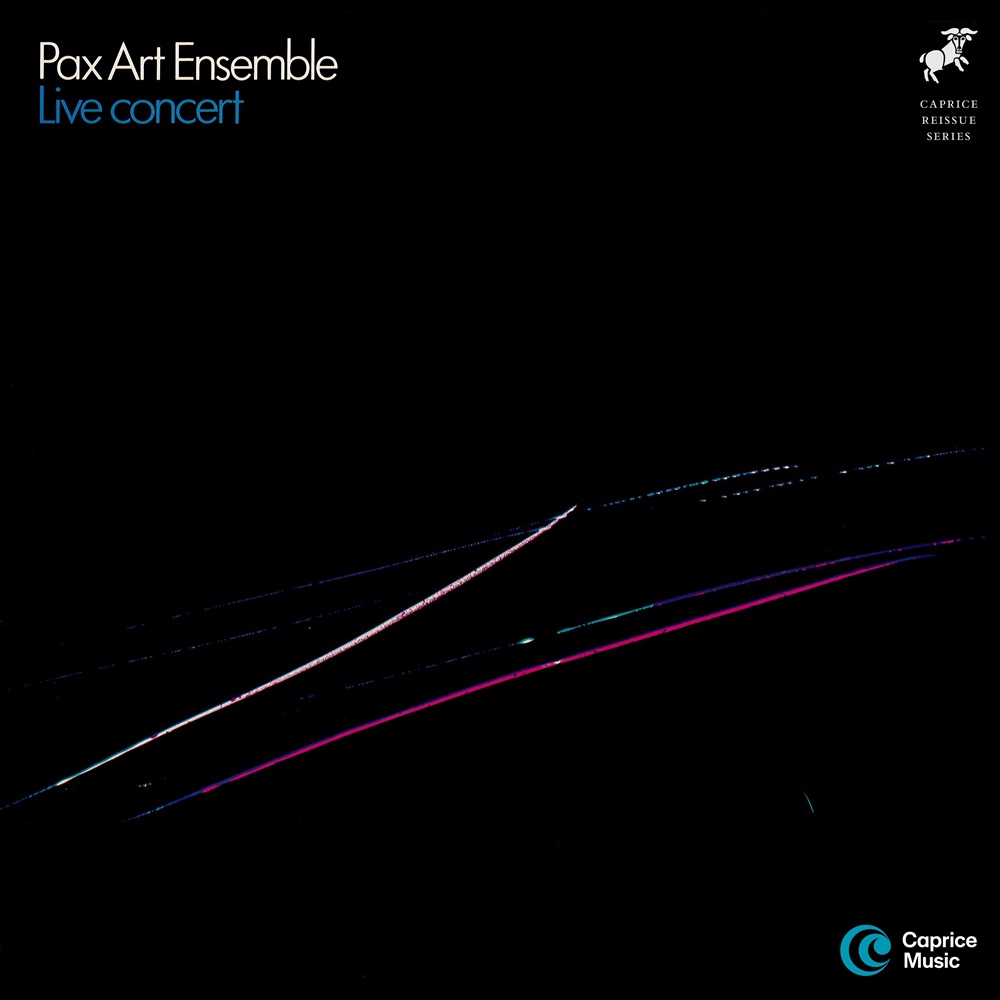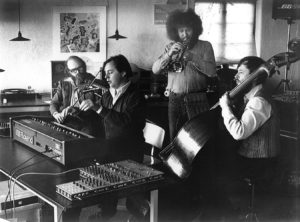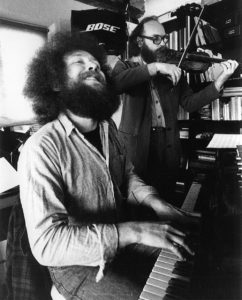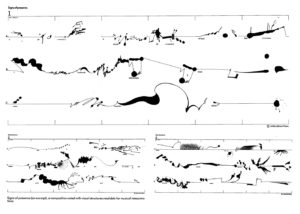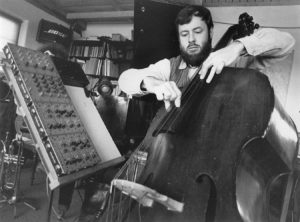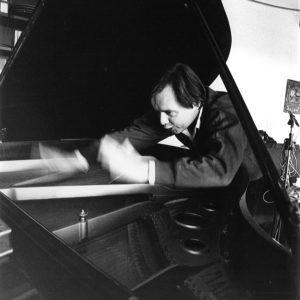Pax Art Ensemble: Live Concert
Leo Nilsson, Arne Olsson, Bo Ingvar Olsson, Gunnar Nilsson
Caprice Music digitally reissues the unique vinyl Live Concert with Pax Art Ensemble. It is now available on all major, and many minor, streaming and download services.
In late 20th century art music, as well as modern jazz music, there is a striving to approach musical composition from an immediate creating in the present moment – improvisation. A meeting between different musical cultures is typical of the age, where both modern Western art music and jazz had come to a point where the styles coincide in free-tonal and improvisational forms.
Pax Art Ensemble began in 1977, to go on exploring this new attitude to music. Two jazz musicians, a composer of modern instrumental and electronic music, and a classically trained violinist – all with different musical backgrounds – sought new tonal structures and musical forms. The instruments consisted of violin, electric violin, trumpet, piano, double bass, Fender bass, percussion, synthesizer, and the live-electronics Dataton System 3000 with individual control from each musician in a 4-channel reproduction system. The result was an entirely new acoustic and electronic sound world.
Pax Art Ensemble. Photo: Hans-Olof Tani
The members of the ensemble felt an urgent need of manifesting an individual content, in contrast to the mass media and reproducing culture that surrounds us daily. They maintained that each day was so new that it demanded its own music, that the signals between us are constantly changing, and that giver and receiver must always be prepared for new encounters.
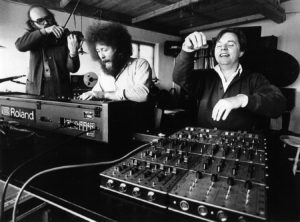
Dialogue as a musical driving force
The development in the music that Pax Art Ensemble played was driven by a dialogue between the musicians that could be likened to the structures arising in verbal language. It reflected in waves the degree of different individuals’ commitment. Someone in the group started a dialogue by putting forward an idea in the form of a rhythmical or other structural theme, which was then commented on, denied, affirmed, or provoked by the rest.
In this way the theme was born and reborn, and the development was driven by what they called the “stimuli of the present moment”, towards a larger and concerted compositional idea, which at times may have seemed symphonic in form.
The music also reflected a dualism between the will to protest and the need of rebirth of the senses.
Forms of collaboration – musicians, painters, poets, dancers, actors
During the years of its existence, Pax Art Ensemble tried to show total openness to, and acceptance of, new incentives in its musical activities. It tried to find new artistic forms in collaboration with painters, poets, dancers, and actors.
Working with different media in dialogue, such as images and music, was also part of the development opportunities that had just become available at the time. For the ensemble, this meant a close cooperation with the visual artists Björn Dahlberg and Al Eklund. Together they worked out program ideas with image technology and content which were then performed in concert situations. On these occasions the pictures had been projected with continuous fade-in/fade-out technique.
Together, they strove to create a dialogue between image and music, and tried to work with both concordance and confrontation. The images also served as inspiration and basis for musical structures. In addition, the group worked with laser lights that were controlled based on the musicians’ instruments.
(The cover art of this record has a photo by Al Eklund, taken from the image-sound composition “Celebration”.)
Signs of Presence (excerpt), edition: Ebba, ©Alf Eklund & Leo Nilsson
Graphic notation
With the aid of graphic notation, one can capture or inspire musical improvisations. It is possible, for instance, to indicate time coordination, dynamics, frequency positions, directions, and different developments with the help of graphical shapes. These musical styles can’t always be written down with conventional notation – the tonal pattern has pried open, and the instrumental sounds and scale systems formerly taken for granted have opened up to a world of sound which cannot really be grasped with pen and paper. Perhaps we should regard the recordings as the “score” for this music. A notation which is graphically interesting, however, can act as an inspiration to musical actions and ideas.
Above, we see an excerpt from Signs of Presence, a graphically notated composition by the artist Al Eklund and the composer Leo Nilsson, first performed by Pax Art Ensemble (Edition: Ebba).
Conventional musical instruments/electronic sound production
With the aid of acoustic instruments, whose sounds can be amplified and filtered, Pax Art Ensemble began working with electronic music, which was created in the studio with unwieldy and bulky apparatus, where the compositions were constructed step by step over a long period. Only later in the development of instruments in the electronic field, it became possible to return to concerts and to perform and interpret electronic music live.
At the recording of this concert, Pax Art Ensemble used the instrument Dataton System 3000 with tone generators, envelope generators, filters, frequency modulators, and mixer, as well as a Poly-Moog and two Roland synthesizers.
Educational activity
Over the years Pax Art Ensemble conducted educational activities as well, under the auspices of Rikskonserter (the National Institute for Concerts) among others. They gave school concerts and visited classrooms, at all levels of elementary school, but also at high schools. There were projects lasting several days at teachers’ training colleges and continuation courses.
At an early stage, Pax Art Ensemble found that it was easier to explain new musical structures by means of images. For some reason, students are more inclined to accept non-figurative pictures than unfamiliar structures in music, and this realization became the basic idea of the pedagogical craft: the image material produced by the students themselves was subsequently translated into new musical tonal structures. Each school concert was prepared by letting the students produce pictures. Musicians and an artist visited the classroom, supervising the work and explaining the instruments.
The results were shown in the assembly hall, where the pictures were magnified, becoming unrecognizably large and magnificent. This image material had music composed for it, which reacted to the form and content indicated in the picture. At lower levels, the students worked with movements and marionettes. The delight of seeing one’s own image and having it interpreted in music was unequivocal – it seems that new sounds, rhythms, and tonal patterns feel more natural and approachable when confronted with an unconventional image.
LEO NILSSON: Poly Moog, Roland synthesizer, live electronics system Dataton System 3000
ARNE OLSSON: trumpet, flugelhorn, grand piano, string synthesizer, Dataton 3103
BO INGVAR OLSSON: violin, electric violin, percussion, Dataton 3103
GUNNAR NILSSON: double bass, bass guitar, percussion, Dataton 3103
Recorded live at the Museum of Modern Arts in Stockholm on 12th August, 1979.
Technician: Studio Viarp
Producer: Pax Art Ensemble
Text: Pax Art Ensemble, Lars Silén, Erik Hamrefors
Translation: Alan Blair, Erik Hamrefors
Editor: Lars Silén
Cover image: Al Eklund
Photography: Hans-Olof Tani
Graphic design: Pontus Reuterswärd
-
1.Live Concert: Part I Music: Pax Art Ensemble
-
2.Live Concert: Part II Music: Pax Art Ensemble
-
- Total playtime


